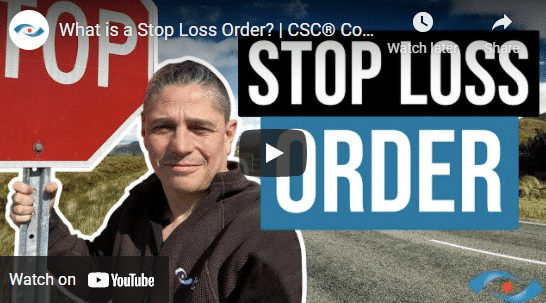A stop-loss order can benefit you. It’s as though you’re telling the exchange and putting them on notice …
Hey everybody, Andre here in the Coach’s Hangout. Well, a few weeks ago, I took a call from a friend of mine that was getting involved in some do-it-yourself investing. In fact, he was doing day trading, which concerned me quite a bit. So I pulled over on the spot and recorded an impromptu Coach’s Hangout video for the benefit of my friend and our viewers. And if you want to check out that video, I’m going to put a link in the description below.
Now, in that video, I talked a little bit about how the stock market worked. Specifically, we discussed the difference between a bid and ask price and different types of orders, such as a market order and a limit order. And in that video, I dropped a hint about this follow-up video, and sure enough, my day-trader buddy took the bait. He gave me a call and said, “Okay, Dre, can you tell me a little bit about this stop-loss order?” Evidently, he must have suffered a loss or two. And if that’s the case, a stop-loss order is, obviously, pretty intriguing.
But before we get into that, I want to cover a couple of things. I wrestled with whether I should record this video in the studio where I have access to the teleprompter, and obviously, the production value is going to be a bit better. But I ultimately decided it made a lot of sense to record this video on my day off, given what we’re going to be talking about. Now today, I don’t have access to my laptop computer. I don’t have access to the internet, and I’m up north, where the Wi-Fi and internet can be wonky at the best of times. And that’s going to make a lot of sense to you when we talk about how a stop-loss order can potentially benefit you.
I also want to address the fact that at SeeWhy Learning, we will often exaggerate when teaching a concept. We find that when we do this, it often makes the concept easier for the student to see and understand. In fact, sometimes, I’ll exaggerate so much because I want the student to look at me with this obvious look on their face and say, yeah, no kidding. And when that happens, I think to myself, you know, mission accomplished. They’ve grasped the concept. So I am going to exaggerate quite a bit here.
You know, let’s suppose you bought ABC shares for $10 per share. And you know, maybe you’re not a day trader. Maybe you’re a long-term-oriented investor, and you think the company’s going to do well, and you want to hang onto it for the long haul. But let me ask you some hypothetical questions. What would you do if the stock price fell to $9? Would you sell it? Well, what if it fell to $7 and then $5 and then $2 and then a buck? Obviously, I’m exaggerating, but I think most of you would agree while at some point, if the price continues to fall, you might just think to yourself, this is not going the way I thought it was going to go. Maybe I made a mistake, and maybe you just want to sell your shares and cut your losses so that it can’t get any worse.
But what if this happened? And I know I’m exaggerating here, but what if this happened all in the same day, maybe on your day off when you’re not following your position? You just come home at night, and you realize that your stock has fallen from $10 to a dollar. And you’re kicking yourself saying, man, if I was following it today, I probably would have sold the shares, but now it’s too late, and I’ve lost quite a bit of money.
Well, that’s where a stop-loss order can benefit you. It’s as though you’re telling the exchange and putting them on notice and saying, listen, if the stock price falls to a certain level, don’t wait for me to call you, and you don’t have to call me. If it falls to that level, I want you to immediately trigger a sell order and try to sell my shares, so at least my losses can’t get any worse. And that’s what a stop-loss order does for you.
So maybe you bought the shares at $10, and you enter a stop-loss order with a trigger price of $6. And that says to the exchange if the price does happen to fall to that level, trigger an order to sell my shares. Now, at that point, once triggered, depending on the exchange, it could become a market order or a limit order. And in the case of the TSX Exchange, when placing a stop-loss order, they will also require you to name a limit price.
Now, I want to stress that if you buy shares for $10 and you enter a stop-loss order for $6, that does not necessarily mean the maximum you could lose is that difference of $4. Certainly, a stop-loss order can potentially help you, but there are no guarantees. Now let me exaggerate again.
What if in the evening, when the stock market isn’t even open, ABC announced some terrible news? Maybe they’re getting sued, and they’re almost certainly heading for bankruptcy. Well, in that case, what would likely happen is the stock price will open in the morning, far lower than $6. And in that scenario, well, your stop-loss order hasn’t done much for you. So there are no guarantees, but a stop-loss order can potentially help you.
Now, if you’re preparing for your exam, if you’re taking the Canadian Securities Course, and you’re using SeeWhy Learning’s exam preparation tools, we’re going to get into a little bit more detail on a stop-loss order. And more importantly, you’re going to have the opportunity to practice. At SeeWhy Learning, we believe that obviously doing your reading is critical, but we believe a good portion of a student’s learning doesn’t necessarily come from the reading. It comes from applying what they read by doing lots of practice questions. And when they get a question right, what our answer key will do is it will confirm their understanding. But if they get a question wrong, our answer key will correct their understanding and that, of course, is where learning occurs.
So one thing that’s really, really important, practice, practice, practice. It does make perfect. Well, thanks for dropping by the Coach’s Hangout. I hope you found this video helpful, and good luck on your upcoming exams.

Recent Videos

Monetary & Fiscal Policy Part 2

Monetary & Fiscal Policy







